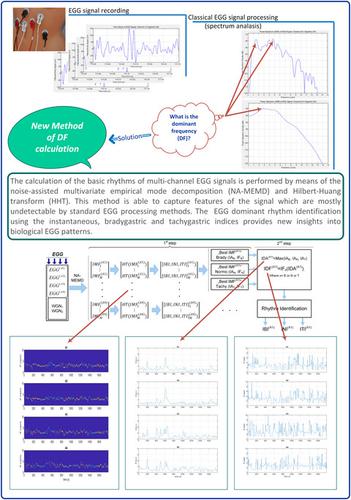当前位置:
X-MOL 学术
›
Neurogastroenterol. Motil.
›
论文详情
Our official English website, www.x-mol.net, welcomes your feedback! (Note: you will need to create a separate account there.)
Gastric slow wave rhythm identification using new approach based on noise‐assisted multivariate empirical mode decomposition and Hilbert–Huang transform
Neurogastroenterology & Motility ( IF 3.5 ) Pub Date : 2020-10-11 , DOI: 10.1111/nmo.13997 Dariusz Komorowski 1 , Barbara Mika 1
Neurogastroenterology & Motility ( IF 3.5 ) Pub Date : 2020-10-11 , DOI: 10.1111/nmo.13997 Dariusz Komorowski 1 , Barbara Mika 1
Affiliation

|
Electrogastrography (EGG) is the method of cutaneous recording of the myoelectrical activity of the stomach. A multi‐channel signal is recorded non‐invasively by means of electrodes placed outside the epigastric area. The normal electrical rhythm of the stomach (slow wave) may become significantly disturbed due to disorders of gastrointestinal tract. Abnormally fast electrical rhythms are termed tachygastria, while abnormally slow rhythms are known as bradygastria. Because some features of biological signals may go undetected using the classical methods of signal spectral analysis, we propose a new method for EGG rhythm identification.
中文翻译:

使用基于噪声辅助多元经验模式分解和希尔伯特-黄变换的新方法识别胃慢波节律
胃电图 (EGG) 是一种通过皮肤记录胃肌电活动的方法。多通道信号通过放置在上腹部区域外的电极无创记录。由于胃肠道疾病,胃的正常电节律(慢波)可能会受到严重干扰。异常快的电节律称为胃过速,而异常缓慢的节律称为胃过缓。由于使用经典的信号频谱分析方法可能无法检测到生物信号的某些特征,因此我们提出了一种新的 EGG 节律识别方法。
更新日期:2020-10-11
中文翻译:

使用基于噪声辅助多元经验模式分解和希尔伯特-黄变换的新方法识别胃慢波节律
胃电图 (EGG) 是一种通过皮肤记录胃肌电活动的方法。多通道信号通过放置在上腹部区域外的电极无创记录。由于胃肠道疾病,胃的正常电节律(慢波)可能会受到严重干扰。异常快的电节律称为胃过速,而异常缓慢的节律称为胃过缓。由于使用经典的信号频谱分析方法可能无法检测到生物信号的某些特征,因此我们提出了一种新的 EGG 节律识别方法。



























 京公网安备 11010802027423号
京公网安备 11010802027423号